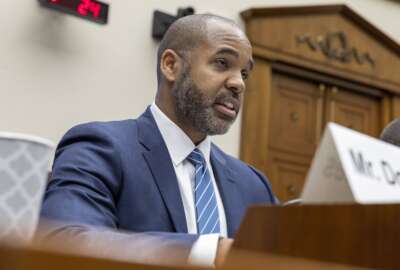Overcoming VA’s struggles with care ‘requires a very different mindset’
The Veterans Choice Act provides VA with the opportunity to redefine what its role will be in 10 years.
Is it possible the Veterans Affairs Department has been approaching health care with the wrong outlook this whole time? Gail Wilensky, a former public health official and senior fellow at the international health organization Project Hope, has been involved in oversight of VA health care since 2001, and said that the Veterans Choice Act provides the department with the opportunity to redefine what its role will be in ten years.
The VA has two options, Wilensky said:
- Provide all healthcare for a relatively small portion of veterans — currently, about 6 or 7 million veterans, out of a total of 22 million, receive all their health care from VA; or
- Primarily be the provider of health care for wounds of war and specialized treatments, while allowing community providers to provide routine care.
Veterans Choice, signed by President Barack Obama in August 2014, allows veterans in certain circumstances to seek care outside the VA system.
That’s the first step, Wilensky said on Veterans Affairs Month, to realizing that you go to the VA for prosthetics or traumatic brain injuries, not a head cold. VA doesn’t always need to be the main provider of routine care for veterans. And planning for that kind of a vision for VA’s future would require a very different outlook.
But Wilensky thinks that while the appointment of David Shulkin to VA secretary brings continuity, it also represents an extension of the status quo.
“There’s nothing to suggest that we are likely to see a major change in the direction of the VA. In some ways that can be regarded as worrisome. There’s not much evidence things have materially improved in the last two years,” she told the Federal Drive with Tom Temin.
And this is not unusual, Wilensky said.
In 2015, Wilensky was a member of the blue-ribbon panel that explored the Mitre Corporation’s report on VA.
“[We] agreed that there needed to be basically a new governance structure of the VA, one that would be empowered to have decision-making with regard to quality improvements and personnel management, data validity, and relatively insulated from direct political action, which is a major problem with the VA,” Wilensky said.
The VA needed, according to the panel, a decentralization of authority in decision-making to the lowest appropriate level, more seriousness in promoting patient-centric care, better approaches to clinical decision-making support systems, and new modern enterprise management tools, like patient scheduling.
“All of those needed to occur if there was going to be fundamental changes to the care provided in the VA,” Wilensky said. “Unfortunately, as we look out now, a couple of years later, it’s clear that despite additional funding, the VA continues to struggle in providing the care that has been promised to the veterans. And that has got to be a source of continued frustration.”
Part of the problem, she said, is that VA continues to try in-house solutions that it isn’t capable of delivering on, like the patient scheduling system and the electronic health records update.
“When pressed, [VA] seems to turn inward, believing it can solve its own problems internally better than going to experts outside,” Wilensky said. “Despite what appears to be a series of problems that have developed when they have tried that. It’s not clear to me why they keep turning inward, when it looks like that has not served them well in the past. Not that going outside is necessarily a winning solution; you can bungle that, as we saw what happened with Healthcare.gov.”
But she said that it can also be easy to focus on the problems and failures.
“VA has always had centers, VA facilities, that provide excellent care, and that has continued,” she said. “They have had a history of too much variation between the best and the worst. We focus on the worst, because we’re concerned about what happens to the care there. But it is a reminder that there are also very excellent VA centers of care, have been historically, many of them closely affiliated with academic health centers.”
The issue is that when these facilities with good clinical results have been interviewed, many of them have reported having to work around decision-making, delivering results in spite of constraints. And unfortunately, that’s not practical to duplicate.
“There are ways … to get the right thing done, but it requires a very different mindset than the kind of mindset that is present all-too-often in the VA right now,” Wilensky said.
Copyright © 2025 Federal News Network. All rights reserved. This website is not intended for users located within the European Economic Area.
Daisy Thornton is Federal News Network’s digital managing editor. In addition to her editing responsibilities, she covers federal management, workforce and technology issues. She is also the commentary editor; email her your letters to the editor and pitches for contributed bylines.
Follow @dthorntonWFED






